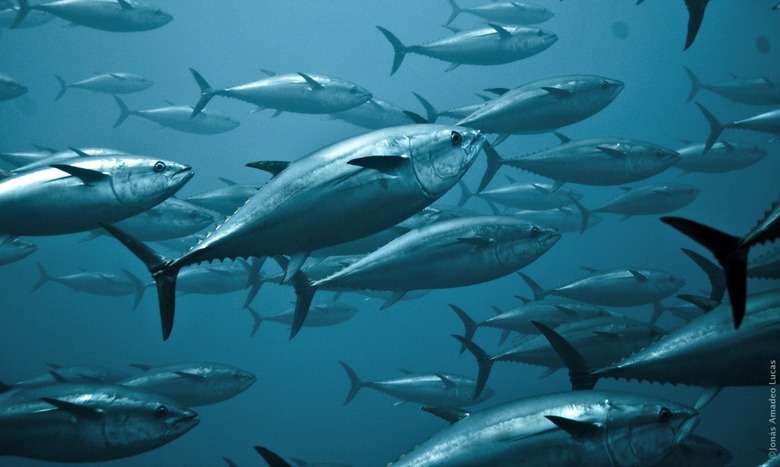Bringing Purity Back Into The Seafood Industry
Seafood is packed full of important nutrients, proteins, vitamins and omega-3s, but lurking in our oceans is a hidden poison that is corrupting the purity of the world's seafood supply — mercury.
Click here for 10 ways to eat (safe) tuna.
While mercury has been in the environment since the planet was first formed, industrialization has caused the levels to rise. Inorganic mercury enters our environment both naturally through volcanic activity and forest fires and through industrial pollution. Emissions from coal-fired power plants are the most significant contributor. And, the annual manmade mercury contribution grows each year with a compounding effect. Additionally, global warming increases the frequency and magnitude of forest fires, which in turn increases the mercury load on our planet. A Michigan University study revealed that mercury levels in yellowfin tuna in the Pacific Ocean have increased by 3.8 percent per year between 1998 and 2008 and predicts that if the mercury pollution continues at current levels, the mercury levels will double in our oceans by 2050.
Mercury in tuna is an issue for consumers because the toxic form of mercury, methylmercury, can be found at higher levels in tuna than other types of seafood. Mercury in its elemental or inorganic form (Hg) makes its way into our lakes and oceans and reacts to create methylmercury (MeHg or MMHg). This organic mercury compound is most commonly found in marine life, and it binds with plant life. Through bio-magnification, in which small fish eat the methylmercury laden planet life, bigger fish eat the smaller fish and so on, the methylmercury concentrations, on average, are higher the farther up the food chain one goes. On average, swordfish have higher mercury concentrations than tuna and tuna have higher concentrations than mussels.
It is important to note that one's body can process trace amounts of methylmercury, like other toxins, without adverse effects. However, chronic exposure to doses of methylmercury from seafood beyond the body's ability to process it can cause serious problems. Chronic elevated mercury exposure in adults impacts the cognitive, motor, and sensory functions. Effects on infants and children can be more severe due to their developing nervous symptoms and their smaller body masses. According to the EPA, children exposed to methylmercury while they are in the womb can have irreversible impacts to their cognitive thinking, memory, attention, language, fine-motor skills, and visual special skills.
As the issue of high methylmercury levels in seafood has become common knowledge over the years, many people's instinct has been to eliminate larger fish, like tuna, from their diets altogether. The problem is that tuna is also a valuable source of nutrients such as vitamins, protein, and omega-3s, so eliminating tuna completely from a diet is disadvantageous.
Another obstacle is the variance of mercury levels between canned tuna brands and within the brands themselves. Brands like American Tuna and Wild Planet try to work around the methylmercury issue by targeting younger, smaller fish in their catches. But, tuna are a highly migratory, predatory species so their diets can vary due to differences in prey and geographic location. Since mercury accumulates in seafood due to bio-magnification, the age of a tuna can have an effect on the mercury content as well. But age is not a reliable factor in determining mercury levels because there is no way to accurately monitor what a specific tuna is eating. If a younger tuna continuously eats prey with higher mercury concentrations than an older tuna with a different diet, the younger, smaller tuna can have higher mercury concentrations than the larger tuna.
There are standards for testing seafood, including tuna, for mercury, which are set by the FDA in the U.S. and by other regulatory bodies in other countries around world. The FDA sets a standard of 1.000 parts per million (ppm), which has been exceeded by canned tuna in multiple studies conducted by universities and regulatory bodies. Other countries such as Canada and most participating countries in the EU have a standard that is half of the FDA's, at 0.500 ppm. However, these standards are rarely enforced because these regulatory bodies do not have the resources to check or verify every brand of tuna and there is no mandatory testing to ensure brands are meeting these standards.
The only way to truly know the mercury level in a tuna is to test each and every tuna.
Safe Catch is the first and only canned tuna brand that tests every fish for mercury. Safe Catch's standard is 0.100 ppm for its Elite (10X lower than the FDA) and 0.300 for its Albacore (3 ½ X lower than FDA). Safe Catch Elite is the only brand to meet Consumer Reports 'Low Mercury' criteria and mercury levels of the Environmental Working Group's 'Best Choice' standard.
The accompanying story is provided by fellow Daily Meal editorial staff member Valaer Murray.
